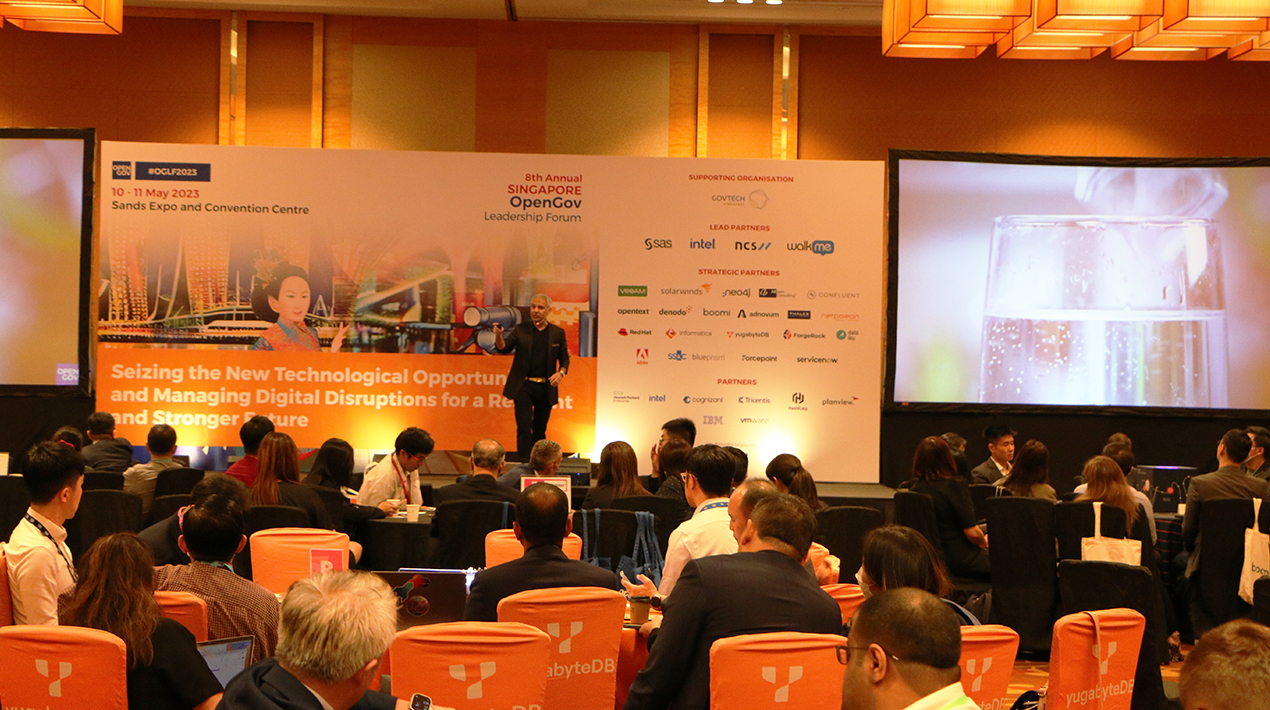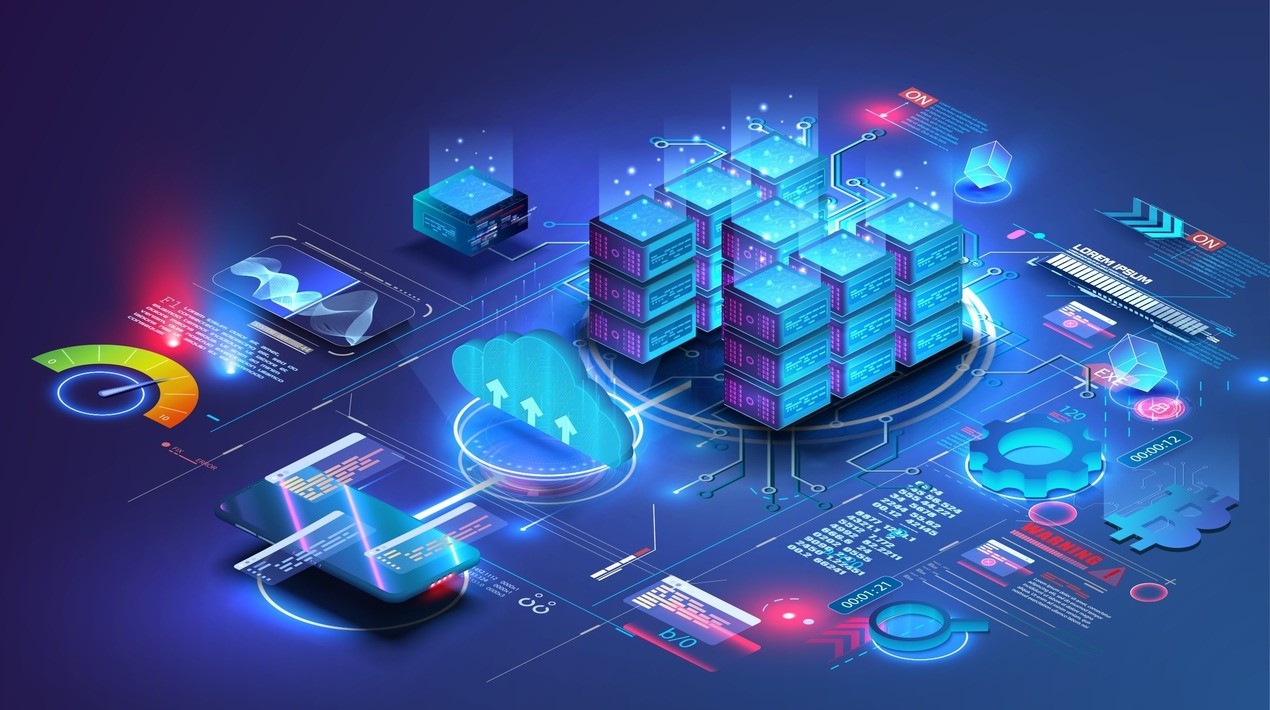
Big Data, Advanced Analytics, Artificial Intelligence (AI), Machine Learning (ML), Content Management, and Emerging Enabling Technologies are all potent tools that can aid organisations in improving decision-making, increasing efficiency and gaining a competitive edge in the market.
Big Data refers to the vast volume of data generated daily by individuals, machines and various processes. With the right tools and technologies, organisations can collect, store, and analyse this data to gain valuable insights into their operations, customers and market trends.
Advanced analytics involves the systematic analysis of data using statistical and predictive modelling techniques to identify patterns, trends, and valuable insights. Through these sophisticated analytical methods, companies can derive a deeper understanding, make informed decisions and can find fresh development prospects based on the outcomes of the analysis.
Artificial intelligence and machine learning are technologies that facilitate machines’ ability to learn and adapt by leveraging data inputs. Through these technologies, machines can acquire knowledge, improve performance, and autonomously adjust their behaviour based on the patterns and insights derived from data.
This enables intelligent decision-making, problem-solving and the development of predictive models that enhance efficiency and accuracy in various domains. Organisations can automate repetitive operations and develop new goods and services that were previously impractical through these technologies.
Content management is the process of organising, categorising, storing and distributing digital content, which can include documents, photos, videos, and other types of media. This procedure involves classifying the content, establishing an efficient storage system and implementing strategies to facilitate the dissemination and retrieval of the content when needed.
Genuine content management. tools and technology enable organisations to effectively manage their digital assets, improve collaboration, streamline workflows, ensure easy access to relevant information and guarantee regulatory compliance.
The key elements of the contemporary digital landscape include Big Data, Advanced Analytics, Artificial Intelligence, Machine Learning, Content Management and Emerging Enabling Technologies.
The advent of Emerging Enabling Technologies such as the Internet of Things (IoT), Blockchain and Cloud computing is transforming the way business is done. These technologies are driving significant changes in business operations, facilitating enhanced connectivity, data security and scalability.
As a result, organisations are leveraging these technologies to improve efficiency, promote innovation and better customer experiences.
By making strategic investments and staying abreast of emerging trends, organisations can position themselves for long-term success in an increasingly data-driven world. These proactive steps enable them to harness the power of data and leverage it effectively to drive growth and innovation.
On the second day of the 8th Annual Singapore OpenGov Leadership Forum 2023 held on 10-11 May 2023 at Sands Expo and Convention Centre, Singapore, technology leaders tackled Big Data, Advanced Analytics, Artificial Intelligence, Machine Learning, Content Management and Emerging Enabling Technologies that help boost the efficiency of the different sectors.
Opening Remarks

Mohit Sagar, CEO and Editor-in-Chief of OpenGov Asia acknowledges that successful integration of new technologies requires a dual focus on building strong technological foundations and providing the necessary education to empower individuals with new skills.
“Developments like generative AI and robotics can be beneficial to society if used responsibly,” he believes. “This approach ensures that the adoption of technology yields substantial benefits and drives positive outcomes, safely.”
Cloud computing solutions, in particular, have emerged as a key driver in enabling organisations to play a pivotal role in promoting climate and environmental stewardship as well as reducing energy consumption within their organisations. Indeed, Mohit observes that Chief Information Officers (CIOs) are taking a leading role in driving sustainability initiatives through the use of technology.
“During the process of migrating company systems and applications from data centres to the cloud or upgrading existing servers, IT leaders often uncover significant opportunities to reduce energy consumption,” Mohit explains. “This transition allows them to identify and implement energy-efficient solutions, contributing to sustainability efforts within their organisations.”
In an increasingly digital-first landscape, the future of the public and private sectors lies in the creation of personalised experiences for citizens and clients. This approach emphasises the importance of the six P’s: People, Product, Process, Prioritisation, Perseverance and Partnerships.
By focusing on these aspects, governments can deliver tailored services, enhance efficiency, prioritise citizen needs, demonstrate persistence in achieving goals, and foster collaboration with key stakeholders to drive successful digital transformation.
Mohit emphasises the importance of maintaining a balance between innovation and risk management within organisations. To achieve this balance, it is crucial to implement robust data management practices and cybersecurity safeguards.
Furthermore, empowering both staff and citizens is essential to ensure the long-term success of digital ambitions. Providing employees and citizens with the necessary tools, such as low-code development platforms, is crucial for promoting innovation and driving successful digital transformation.
“By enabling individuals to actively participate and contribute to digital initiatives, agencies and companies can harness people’s creativity, expertise and ideas, leading to more effective and impactful digital outcomes,” Mohit is convinced.
The incorporation of developing technologies such as AI, ML, and intelligent automation opens new avenues for organisations to prosper and meet the needs of their consumers and citizens. To navigate the complex terrain of problems and opportunities, organisations must take a holistic approach that incorporates observability and AIOps while leveraging cloud-native design.
To accomplish this, they must adapt and change in response to new challenges and opportunities, with an emphasis on people and partnerships to drive innovation and digital transformation.
Mohit acknowledges that digital transformation presents both opportunities and challenges. By embracing the latest technologies and adopting best practices, organisations can seize these opportunities and reach new heights of success.
Simultaneously, they must navigate risks, adapt to change and embrace new challenges in the complex landscape. Agility and proactive measures are key to achieving success in this VUCA world.
“Ultimately, by embracing developing technologies and taking a holistic approach, organisations can prosper in the digital landscape, meeting consumer needs through innovation and automation,” Mohit concludes. “Navigating challenges requires adaptability, people-centric innovation and proactive measures for success.”
Technology Case Study: Unleashing the Power of Advanced Analytics with Lightning-fast Access to Accurate Insights For Better Citizen Outcomes

Kenny Sng, Chief Technology Officer for Singapore & Malaysia at Intel explores the power of big data and analytics for success in a constantly evolving digital environment.
He identifies the five superpowers that accelerate growth across sectors. These include Sensing, the latest addition, Ubiquitous Computing, Pervasive Connectivity, Cloud to Edge Infrastructure and AI – Intelligence everywhere.
Kenny highlights that computing capabilities, serving as the bridge between people and technology, are impacting every aspect of life, whether through established or emerging form factors.
As new form factors emerge and real-time analytics drive intuitive digital workflows, computing is transitioning from being a task people perform to becoming an integral part of how they experience the world, making work and play more seamless and enjoyable.
“Everyone and everything are connected,” says Kenny. “Universal connectivity is enabling customers to collect, store, move, and analyse large data sets, enabling the design and delivery of incredibly innovative business models, products, and services.
Cloud to Edge Infrastructure is establishing a dynamic, dependable path for connected compute data. Organisations are utilising distributed networks and harnessing the power of the Intelligent Edge to process workloads closer to customers.
The combination of unlimited cloud scale and capacity along with the extensive reach provided by the Intelligent Edge offers unprecedented opportunities for growth and expansion. This empowers them to deliver data-driven digital services and personalised experiences that cater to the specific needs and desires of their customers.
Kenny reiterates that turning endless data into actionable insight implies allowing AI to extract more value from data everywhere. “Customers benefit from AI by automating crucial processes, unleashing the creativity of their teams and delivering digital goods and services that end consumers like.”
The new fifth superpower harnesses the abundance of data generated by smart devices at the edge, combined with advancements in automation, processing, inference and software, enabling machines to possess human-centric capabilities.
The healthcare industry is witnessing foundational changes, such as a shift towards value-based care, personalised treatment plans and greater patient engagement. These trends are supported by advancements in genomics, biomarker diagnostics, and digital transformation while ensuring robust security measures to protect patient privacy.
The rapid advancements in healthcare are driving the development of analytics tools, virtual care solutions, and multi-cloud environments. Organisations must stay informed about these developments and engage in open discussions to effectively adapt and meet the evolving needs of the industry.
The integration of clinical and business procedures and equipment into a cohesive technology framework, spanning from the edge to the cloud, enables hospitals to achieve scalability, broad data access, faster workflows and improved patient care. This unified infrastructure empowers healthcare organisations to leverage technology for enhanced operational efficiency and better healthcare outcomes.
“Emerging technologies, like the five superpowers, are propelling sectoral growth and reshaping the way people interact with computing,” Kenny opines.” Universal connectivity, cloud-edge infrastructure and advancements in various industries are revolutionising processes, optimising efficiencies and delivering enhanced experiences for individuals and businesses worldwide.”
Fireside Chat: Why Having a Digital Adoption Strategy is a Game Changer

During the Fireside Chat moderated by Ang Lee Yen, Director, Asia, WalkMe, Justin Ang, Assistant Chief Executive for Media, Innovation, Communications & Marketing, Infocomm Media Development Authority (IMDA), Singapore said their organisation is the architect of Singapore’s digital future.
They have taken up the mantle of overseeing the media industry, spearheading innovative marketing initiatives and fostering a thriving ecosystem of innovation and technology.
Thus, IMDA, under its purview, has designed the advancement of a vibrant digital economy where technology and media are harnessed to their fullest potential by corporations, governments, individuals and every facet of society.
IMDA firmly believes that to spur innovation among companies in Singapore, one effective approach is to accelerate the growth of technology startups. By focusing on nurturing and supporting these emerging ventures, IMDA aims to create an environment conducive to rapid innovation and development within the tech industry.
Their efforts are directed towards enabling startups to flourish, thereby driving overall innovation across the country. This is done by opening access for startups, matchmaking with investors and helping gain access to foreign markets.
IMDA acknowledges WalkMe as a trailblazer and frontrunner in the realm of digital adoption platforms (DAPs). In a collaborative effort, WalkMe has supported IMDA in implementing two key programmes, namely Accreditation and Spark.
Through IMDA’s Accreditation program, companies operating in Singapore can obtain official accreditation, signifying their adherence to specific standards and criteria. Spark helps support and accelerate the growth of tech startups in Singapore.
The partnership between IMDA and WalkMe has been instrumental in enabling over 100,000 government agencies in Singapore to leverage the benefits of digital adoption platforms (DAPs) and artificial intelligence (AI). Through this collaboration, startups based in Singapore have been able to provide a diverse range of services, empowering government agencies to adopt and utilise DAP and AI technologies effectively.
“According to an IMDA survey, despite more than 90% of organisations investing in digitalisation, the outcomes have not been optimal,” Justin reveals. “This is because there are still many employees who do not fully understand or take advantage of the power of digital tools that organisations have purchased to help their productivity. Employees instead view the tool as an unnecessary additional hurdle in their workflow.”
Consequently, employee resistance arose during the adoption of the new system, leading to either insufficient acquisition of the necessary knowledge to maximise the tool’s potential or a tendency to abandon it midway.
The DAP WalkMe Guide provides step-by-step guidance so employees can get the most out of the digital tools the company has purchased and use them properly.
In addition to supporting startups, IMDA has played a crucial role in shifting the mindset of larger firms regarding digitalisation, particularly those with a top-down organisational structure, regarding digitalisation. They have actively addressed the challenges and costs associated with the process, helping these firms embrace a new perspective and approach towards leveraging technology for their benefit.
IMDA assists organisations in Singapore by helping them identify technological solutions to address their business challenges and uncover efficiencies. By leveraging its expertise, IMDA supports businesses in finding appropriate technological interventions that can enhance their operations, streamline processes and overcome hurdles they may face.
“Many companies lack awareness or understanding of the available technologies that can help them find solutions to their business problems. So, at IMDA, helping plays a role to guide them,” Justin explains.
To address this issue, IMDA has established the Pixel Innovation Hub, which offers free webinars aimed at educating companies about the latest technology relevant to their business needs. Through these webinars, IMDA aims to equip organisations with the knowledge and understanding necessary to make informed decisions about leveraging cutting-edge technologies for their specific requirements.
IMDA further supports companies by providing a physical storefront where they can witness and gain a firsthand understanding of how specific solutions are implemented. This initiative allows organisations to explore practical demonstrations and gain valuable insights into the deployment of various technologies, enabling them to make informed choices based on real-world examples.
IMDA operates Singapore’s largest open innovation platform, which catalyses collaboration between large and small companies. Through this platform, companies are challenged to work together in addressing common problems, foster partnerships and identify potential business collaborators during the event.
The platform creates an environment where companies can pool their expertise, resources and ideas to collectively find innovative solutions and unlock new business opportunities. It offers accelerated innovation, expanded market reach, risk mitigation enhanced customer experience and increased agility.
“These collaborations are instrumental in driving business growth, fostering innovation, and staying competitive in the digital era,” Justin concludes.
Technology Case Study: Accelerating Digital Transformation Without Compromising Your OPEX

Hon Chew Seetoh, Boomi’s General Manager for Asia, acknowledges that organisations face a significant challenge in simultaneously accelerating digital transformation and effectively managing operational expenses (OPEX).
Balancing the need for rapid technological advancement with cost efficiency is a crucial task for businesses aiming to drive digital initiatives while maintaining financial stability.
Achieving this objective entails formulating a well-defined digital strategy that entails performing comprehensive cost-benefit analyses, cultivating an innovative culture and adopting data-driven decision-making practices.
“We who are in the IT industry often pride ourselves on being at the forefront of innovation and advancement,” Hon Chew observes. “However, sometimes, we must look outside our industry to see how others solve their problem.”
An impressive example of this resilience and efficiency is a corporate car manufacturing a Model 3 vehicle every 43 seconds. Despite challenges such as supply chain disruptions, workforce shortages, the impact of COVID-19, heightened shareholder expectations and demanding CEO requirements, the organisation was successful.
While the process of building an automobile may differ from constructing a technological stack, there are underlying similarities when considering first principles. Regardless of the context, customer expectations remain unchanged and should not be compromised.
“Whether it’s manufacturing cars or developing technology solutions, delivering on customer expectations and providing a high-quality experience is paramount, regardless of the challenges faced.” Hon Chew reminds the delegates. “You must handle the problems without additional Opex and Capex; and works out the bottlenecks in your manufacturing process.”
While existing approaches may not resolve modernisation blockages, there are alternatives, such as dev-centric heavyweight suites and point-to-point tools. By eliminating silos and encouraging cross-functional collaboration, organisations can leverage the collective expertise, resources, and perspectives of their teams to solve problems more comprehensively and effectively.
Hon Chew highlighted the implementation of the data journey, which involves the utilisation of pervasive connectivity by Unified to offer solutions to all consumers. This approach ensures that data flows seamlessly across various systems and devices, enabling Unified to deliver comprehensive and efficient solutions to its customers.
By leveraging pervasive connectivity, Unified strives to provide a connected experience that meets the diverse needs of consumers across different platforms and devices. The implementation also encompasses data readiness, which involves identifying and transforming high-volume data into high-value data, as well as user engagement, which facilitates data-driven end-user consumer experiences.
Intelligent integration and automation have the potential to revolutionise business operations by connecting systems, automating workflows, leveraging data insights and improving customer experiences. It enables organisations to increase productivity, decrease expenses and obtain a competitive edge in the rapidly evolving digital landscape of the present day.
The Boomi platform is designed to run across multiple environments, including multi-cloud, on-premises and edge. As a pioneer in the Integration Platform as a Service (iPaaS) field for over two decades, Boomi is recognised as a market leader. Their platform supports cloud-native applications, data integration, process integration, and B2B integration scenarios, providing comprehensive solutions for various integration needs.
Boomi offers a comprehensive platform with a wide range of capabilities, enabling organisations to reduce labour costs, achieve fast time-to-value and support various integration scenarios, including cloud-to-cloud, cloud-to-on-premise, on-premise-to-on-premise, or hybrid combinations. Additionally, they provide customers with total control over data domicile, ensuring data is stored and managed according to their specific requirements.
Partnering with technology companies or service providers, in his opinion, helps speed up digital transformation while controlling expenses. He recommends looking for partnerships that provide experience, scalable solutions and affordable pricing structures.
“Organisations need to leverage their expertise and resources to enhance their capabilities without significantly increasing operational expenses (OPEX),” Hon Chew concludes. “By making the most of their existing knowledge and assets, organisations can optimise their performance and achieve their goals while keeping costs under control.”
Technology Case Study: Rethinking Databases in the Age of Digitalisation

Vish Phaneendra, Head of Solution Engineering, APJ, YugabyteDB, highlights that the current transformation taking place in the IT industry is primarily motivated by the ever-changing demands of businesses.
Therefore, the rapid advancement of technology necessitates the availability and effective management of data. Robust database management plays a crucial role in facilitating the seamless integration and successful implementation of various technologies.
“The goal is for the system to be able to process large volumes of data stored in one place and serve multiple users to read and modify data simultaneously quickly and easily,” Vish explains. “The database serves as a catalogue of information to help keep data organised in a systematic manner.”
The business competition encourages companies to provide data access anywhere, provide always active services, and provide edge services. To enhance business competitiveness, organisations need to renew their applications and upgrade their infrastructure, followed by modernising the data layer.
By embracing modern data storage services, businesses can stay ahead in the market and leverage the full potential of their data for improved performance and strategic decision-making.
However, the current solutions cannot provide a problem-free data layer. During the modernisation process involving cloud adoption, microservices and other advancements, legacy databases often struggle to keep up with the required agility and flexibility.
Current cloud-native applications often have demands that legacy databases are not designed to handle, resulting in additional costs and complexities when it comes to data engineering and management.
Modern database and data layer support offer the desired flexibility and agility that developers of modern systems expect, enabling them to efficiently meet the demands of today’s fast-paced technological landscape.
YugabyteDB is a fully open-source distributed SQL database system that combines the capabilities of SQL database systems with distributed database systems. The company’s technology offers a powerful solution for efficient data management and processing. The combination of the two is a two-layer architectural solution: an extensible query processing layer and a distributed document store.
“For YugabyteDB, it’s not just the amount of data created that matters; the ability to reliably store that data anywhere and access it at any time is also indispensable,” Vish elaborates. “The two-layer architecture solution can serve complex queries and transactions that are demanded by various modern applications. This complexity goes beyond simply storing and loading values or documents with unique keys.”
Relational databases and SQL were specifically developed to ensure the consistent representation of enterprise information systems, even when dealing with concurrent access and complex business transactions. Their purpose is to provide a reliable and structured approach to managing and retrieving data in a way that maintains data integrity and enables efficient data manipulation.
When scaling more than one server is needed, modern database technology can combine data distribution features across multiple servers and enable consistent cross-node transactions. Organisations can deliver critical business results with distributed SQL by accelerating productivity, reducing costs and lowering risk.
Several aspects differentiate a distributed database from a traditional database:
- A cloud-native database must be able to survive system failures without losing any data and recover automatically.
- Advanced scalability. The most important characteristic of a cloud-native database is its ability to adapt to workloads to accommodate dynamically increasing workloads.
- As important as scaling up, it’s also important to scale down as workloads decrease to ensure that you’re only paying for the resources you need.
- The process of deploying and managing a cloud-native database must be codified to achieve automation.
- Cloud-native databases need to be accessed through deployment systems that make them integral to processes and through familiar APIs.
In general, database modernisation is done in two ways, re-platforming and refactoring. Re-platforming is usually done by moving legacy monolithic databases to modern data layers. Refactoring is usually done by rebuilding the application as a microservice and supporting it with a modern data layer.
“YugabyteDB offers Voyager, a tool that simplifies the process of migrating and modernising databases,” Vish reveals. “YugabyteDB Voyager accelerates cloud-native adoption by freeing critical application data from legacy database constraints.”
With Voyager, users can seamlessly migrate their existing databases to YugabyteDB, enabling them to take advantage of its modern capabilities and distributed architecture.
This tool streamlines the migration process, making it easier for organisations to adopt and leverage YugabyteDB for their data management needs. This one-stop solution eliminates complex manual and planning processes to speed up the database modernisation process.
Power Talk: Turning Your Data Dreams Into Reality

According to Sutowo Wong, Director of the Data Analytics Division at the InfoComm, Technology & Data Group, Ministry of Health, Singapore, the healthcare sector faces challenges in harmonising and deriving meaningful insights from data due to variations in coding standards and practices across different institutions.
To comprehend healthcare data at a national level, it is crucial to address and bridge these differences. Achieving this is a complex process that necessitates business compensation and the establishment of common definitions
“For instance, even measuring something as simple as a length of stay can vary among institutions,” Sutowo explains. “The absence of standardised definitions makes it challenging to draw accurate conclusions from the data, underscoring the significance of proper data interpretation.”
Singapore aims to maintain a healthy population and deliver quality care while ensuring sustainability. The pandemic further highlighted the importance of managing costs and addressing the needs of the people, as reflected in the impact on the government surplus.
Utilising machine learning and graph technology to detect and tackle fraud, waste and abuse is a valuable application, contributing to a sustainable cost trajectory for a healthy population.
Understanding behaviour change is crucial and digitalisation plays a significant role in analysing engagement sessions, transcribing them into text and employing topic modelling techniques to identify citizens’ critical concerns.
Technology facilitates the rapid generation of actionable insights from these conversations, expediting the process of extracting valuable and actionable information from the data collected.
Data-sharing misconceptions exist, but the Personal Data Protection Commission (PDPC) has effectively balanced business innovation and consumer protection through careful exemptions and data portability measures. Clear and transparent policies are vital and individuals should take the time to understand them instead of adopting a risk-averse stance.
Data sovereignty has gained importance, leading to a focus on privacy-enhancing technologies such as federated learning. This approach allows the model to be brought to the data instead of centralising the data, promoting trust and overcoming performance issues.
“Technology plays a crucial role in facilitating secure and trusted collaboration among individuals and organisations. When designing or implementing a strategy, there are two fundamental points to consider,” Sutowo believes.
Firstly, individuals frequently overlook the importance of thoroughly reading terms and conditions, blindly ticking the box while subscribing to websites. However, they later complain about limited data available to the government or vendors. This underscores the need for individuals to take responsibility for understanding privacy policies and data-sharing agreements.
Secondly, it is necessary to rethink the data-sharing paradigm. Instead of relying on explicit permission each time personal data is accessed, there is a shift towards more personalised and targeted engagement in the long run. Although this approach may limit immediate marketing opportunities, it prioritises respecting individual preferences over time.
“The evolution of data policies and privacy considerations is ongoing, and these points emphasise the importance of individual awareness and the need for a nuanced approach to data sharing,” Sutowo points out.

For Kingsley Dsouza, Senior Product Specialist, APJ – Data Governance Solutions, Informatica, there are two significant challenges to address: complex data relationships and the expectation of real-time data systems.
“Consumers desire instant access and convenience, whether it’s for completing appointments or receiving invoices,” he explains. “In critical situations, such as transferring patient data between doctors, time is of the essence. This sense of urgency extends beyond the healthcare industry and applies to sectors like financial services as well.”
Technology plays a pivotal role in meeting these heightened expectations. However, complexities arise in integrating different systems and collaborating with technology partners. Overcoming these challenges is essential to deliver seamless and timely experiences for users, ensuring efficiency and accuracy in data management and exchange.
Determining the criticality of tasks and data is crucial. Certain tasks demand immediate attention, while others can be attended to within a few minutes or even a day.
Understanding the urgency and priority of each task allows for efficient resource allocation and effective time management, ensuring that critical tasks are addressed promptly while non-urgent tasks are appropriately scheduled for later attention.
To cater to diverse needs, a combination of platforms is required to address different data management requirements. It is important to consider not only the technological aspect but also the business objectives and real-time data needs.
“Understanding the information as a data engineer and extracting meaningful insights is crucial for building effective AI/ML models that enhance the customer experience. In the end, the goal is to leverage data intelligently to deliver better outcomes for customers,” Kingsley concludes.
Daniel Ng of Neo4j suggests that shifting the focus of data managers to using data for life-saving purposes can bring about a change in their mindset. “While acknowledging the success of contact tracing during the COVID-19 pandemic, it is essential to recognise that data is a tool in the larger objective of preserving lives.”
Several key aspects need to be considered, beginning with the implementation of a standardised data management platform to centralising data. Additionally, cybersecurity measures, access control protocols and governance complexities must be effectively addressed to ensure the security, integrity, and proper management of the data. Singapore is recognised for its advancement in this area.

The legal framework governing data usage plays a crucial role. While technology is essential, it alone is insufficient. Alignment with supportive laws and regulations ensures the ethical and responsible use of data, safeguarding privacy, security and the rights of individuals.
By establishing a robust legal framework, organisations can leverage technology effectively and ethically, promoting data-driven initiatives that have a positive impact on healthcare outcomes and ultimately contribute to saving lives.
Therefore, a technology platform that connects data, coupled with robust cyber laws, enables effective data sharing across different agencies. By considering these factors, the objective of saving lives can be better accomplished.
The relevance of data varies depending on its importance to specific ministries or sectors. What may be critical data for the Ministry of Manpower might not hold the same level of significance for the Ministry of Health.
Each entity or sector has its unique data requirements and priorities based on its specific mandates and objectives. Recognising this distinction allows for tailored data management approaches and strategies that align with the specific needs and priorities of the organisation, enabling them to make informed decisions and drive impactful outcomes in their respective domains.
When assessing relevancy, it may seem tempting to consider all factors equally important, answering “all of the above”. However, evaluating the total impact helps determine the relevancy factor.
Real-time capabilities play a particularly crucial role in the context of hospitals and have been utilised in that setting for a significant period, enabling timely decision-making and enhancing patient care. It not only plays a critical role in customer service and life-saving scenarios but also proves essential in promptly updating medical records.
To effectively manage and prioritise relevant and important data for each entity, the implementation of a data platform is necessary. Such a platform considers the specific needs of customers and ensures that the most relevant data is readily accessible.
Daniel highlights the increasing interest in data sharing facilitated by platforms such as Informatica’s data marketplace. This marketplace enables users and agencies to publish and access data models without directly exposing the underlying data.
Provisioning, which involves the application of policies when accessing data, is a crucial aspect that needs to be addressed. By implementing proper provisioning mechanisms, organisations can enforce data governance policies, access controls, and security measures to ensure that data is accessed and utilised in a controlled and compliant manner.
This helps maintain data integrity, privacy and security while enabling authorised users to access the data resources they need for their specific roles and responsibilities.
“It operates similarly to an online shopping platform, where users can browse and select trusted sources of information. The data marketplace provides a centralised and trusted platform for data discovery and access,” Daniel concludes.
Technology Case Study: Transforming Digital Experiences For Government: Balancing Experience, Trust and Inclusion

Chak Ming Fai, Director, Solution Consulting, South East Asia, Adobe, highlighted the transformative impact of the growing demand for digital public services, which has reshaped citizens’ expectations and challenged governments’ fundamental capabilities and core competencies.
The current landscape requires government services to be connected, responsive, and delivered on the terms of digital natives, while also ensuring inclusivity for all communities.
Singapore’s global leadership in digital accessibility is evident through an assessment of digital equity maturity. However, the evaluation also highlights areas where improvements can be made to further enhance the country’s standing.
Chak Ming believes that citizens have high expectations for government services, expecting them to meet or exceed the quality standards set by the private sector. This observation is supported by reports that indicate: 93% expect the government’s service quality to be on par with leading tech companies and the private sector, 80% start their journeys through digital channels and 87% believe that great digital government customer experience would increase their degree of trust.
“The citizen’s experience is a crucial factor in driving improved outcomes for both citizens and the government,” Chak Ming is convinced. “They expect improved outcomes in terms of accessibility, convenience, satisfaction, and empowerment through government services.”
At the same time, the government aims to achieve improved outcomes in terms of service efficiency, data-driven insights, innovation and collaboration and public trust and transparency.
To drive improved outcomes for both citizens and the government, it is essential to adopt a citizen-centric approach. This includes:
- User-Centred Design: Designing government services with citizens in mind, considering their needs, preferences, and capabilities.
- Seamless Interactions: Creating a seamless and integrated experience across different touchpoints and channels, ensuring consistent and personalised interactions.
- Proactive Engagement: Anticipating citizen needs and reaching out to them with relevant information, updates, and opportunities for engagement.
- Continuous Improvement: Collecting feedback, measuring satisfaction, and using the insights to continuously enhance services and address pain points.
By prioritising the citizen’s experience, governments can foster a more citizen-centric and responsive approach, leading to improved outcomes, greater citizen satisfaction and a stronger relationship between citizens and the government.
Chak Ming acknowledges that governments are deploying strategies to meet increased citizen demands while focusing on fiscal constraints and cross-government efficiencies. These initiatives encompass driving engagement and service adoption, promoting digital equity in public services, enhancing employee productivity, and updating technology and operating models.
Adobe assists the government in meeting citizen expectations by providing consistent and personalised experiences at scale. This includes reinventing the citizen experience, delivering inclusive government services, modernising the public sector experience and streamlining operations to enhance speed-to-service.
“Similar to consumer experience, the majority of states are currently at the emerging level and no state has yet implemented a centralised customer portal,” Chak Ming elaborates. “But leading states stand out by personalising the customer experience through top services, inquiries, and portals, as well as digitising high-priority applications.”
They discovered that the majority of state websites are designed for desktop use rather than mobile devices. This is inconsistent with an inclusive and accessible strategy, considering that most constituents prefer to access government websites and information through their mobile devices.
Mobile site performances, on average, are 44% slower compared to desktop sites. This performance gap highlights the need for improvement in optimising websites for mobile devices to ensure a seamless and efficient user experience for constituents on their preferred devices.
Across all states, the digital social equity dimension exhibits the most significant disparities in scores. When it comes to digital equity, more than half of the states fall into the nascent category, indicating that there is still considerable progress needed to ensure equal access to digital resources and opportunities for all citizens.
By prioritising customer experience and implementing features such as high contrast, improved readability, larger text sizes, and text-only pages, there is a significant opportunity to enhance the accessibility and comprehensibility of websites. Additionally, offering a wide range of language options and services further contributes to making websites more user-friendly and inclusive for a diverse audience.
Chak Ming reiterates that leading governments recognise that investing in the citizen experience yields numerous benefits, including increased citizen satisfaction, improved service delivery, enhanced transparency, and cost savings.
“By placing a strong emphasis on citizen-centric approaches, governments can actively cultivate stronger relationships with their citizens. This focus on citizen needs and preferences helps to build trust and fosters a sense of inclusivity and collaboration,” he concludes. “As a result, governments can drive positive socio-economic outcomes by aligning their policies, services and initiatives with the aspirations and well-being of their citizens.”
Technology Case Study: Total Experience For Government

Government organisations recognise the need to prioritise the integration of information and people-centric approaches to thrive in the new normal. In an increasingly digital landscape and VUCA environment, citizens need to be connected.
Agencies endeavour to digitise and transform their operations to enhance performance and service delivery, as they understand that a positive Employee Experience (EX) directly translates into an improved Customer Experience (CX).
Mike Hooper, Director of Business Value Consulting, APAC, OpenText, observes that numerous government agencies have elevated EX and CX to the forefront of their priorities. Although both are undoubtedly crucial, they are often addressed separately, leading to missed opportunities for genuinely transformative interactions.
“The future of public sector service is in flux. Governments must adapt and contemplate how to improve employee and citizen interactions,” Mike explains. “With the advancement of technology, shifting demographics, and evolving citizen expectations, government agencies are undergoing a process of reassessment and redesign to redefine how work is carried out.”
There is a clear correlation between employee satisfaction and citizen satisfaction. When employees are content and motivated, they are more likely to deliver exceptional service. However, it’s important to note that enhancing experiences cannot be achieved instantaneously and requires a thoughtful and ongoing effort.
There must be synergy between people, processes and technology interact to produce the most significant change. By focusing on a holistic approach, government agencies can create harmony between employees and citizens, resulting in enhanced outcomes for all.
Therefore, the concept of Total Experience (TX) emerges as a strategic method that aims to unite and integrate employee and consumer experiences, fostering superior shared experiences for the benefit of everyone concerned.
OpenText plays a significant role in assisting numerous energy companies, including 19 out of the world’s top 20 largest ones, in organising what is commonly known as unstructured data. Their expertise enables these companies to effectively structure and manage vast amounts of unstructured data, empowering them to derive valuable insights and make informed decisions in the energy sector.
Among the most prevalent types of unstructured data that OpenText helps energy companies capture, govern, and securely exchange are:
- Controlled content such as engineering drawings, operations manuals, legal contracts, and other content across the enterprise that if left unstructured compromise project delays and HSE risk.
- Supply chain and broader business network automation to keep critical equipment running
- Personalised and digital experiences for energy companies that strategically want to move closer to the end consumer as the number of energy choices they have increased
- Cyber resilience as external threats to our energy and utility infrastructure rise.
The energy sector is currently experiencing an unprecedented period where companies face the need to not only survive but also adapt and change in response to significant market forces. The ability to effectively respond and adapt to these strong market forces is crucial for long-term success and sustainability.
This volatile environment requires energy companies to navigate and thrive amid ongoing shifts in regulations, advancements in technology, changing consumer demands and other influential factors. Implementing modernised information management practices can significantly enhance the resilience and strength of energy companies.
“I find managing, comprehending, navigating, and negotiating with ones and zeros, data, and computers to be relatively simple,” Mike reveals. “Contrarily, digitisation is far more complex. It poses multiple challenges, not only in the public sector but across various industries, as it primarily revolves around people rather than just data.”
There is a distinction between digitalisation and digitization. Digitalisation is the process of converting current processes to use digital technologies, as opposed to digitisation, which is the process of making analogue information digital.
“To put it another way, digitalisation is for processes, whereas digitisation is for information,” says Mike.
As the primary providers of services, governments have a high number of interactions with individuals. As such, the digitalisation of government has the potential to bring about significant impacts on productivity, accountability, and transparency.
A committed government embraces digital transformation and becomes data-driven. This allows for more efficiency, accountability and openness in all aspects of its operations, as well as direct communication with the citizens it serves.
Mike believes that governments must prioritise digitalisation to catch up to other industries that have already transitioned to online, 24-hour operations. This shift will allow governments to better serve their citizens while also driving economic growth and achieving a variety of societal advantages.
The demand for speedier, digitally enabled service delivery is growing in the public sector. AI, automation and cloud technologies are assisting agencies in meeting this demand. They can streamline routine tasks, freeing up valuable time and resources for employees to focus on complex and value-added activities, ultimately leading to improved outcomes for both employees and citizens.
By incorporating automation and artificial intelligence into their day-to-day activities, employees can redirect their efforts towards more critical and high-level concerns. This shift allows employees to experience increased job satisfaction and be better positioned to deliver enhanced experiences for citizens.
“To be genuinely experience-driven, government agencies must stop treating customer and employee experiences as separate disciplines and instead adopt a TX approach to interactions,” Mike suggests. “Agencies can improve citizen outcomes, reduce errors and costs in government processes and programmes, and attract and retain a more engaged workforce with a more comprehensive strategy.”
However, despite the potential that digital technologies offer the government, innovating via a TX perspective has its challenges. Future government will be based on experience, but getting there will not be easy. As with any novel endeavour, government leaders will face unique obstacles when constructing experience-driven agencies.
Acknowledging the importance of information management and consolidating information ecosystems is vital for the success of digital transformation. To achieve successful digital transformation and fully leverage the advantages of a unified platform, it is crucial to tackle the siloed nature of critical information and prioritise information management.
“By selecting the appropriate platform, businesses can increase their digital agility and leverage previously dormant information source knowledge,” Mike knows.
OpenText stands out with its unique capability to offer a comprehensive end-to-end content management platform. This platform consists of three fundamental layers of functionality: storage and compliance, business process, and customer experience. All are available as a fully managed cloud service and are integrated with your core systems, such as SalesForce and ServiceNow.
“OpenText provides a holistic solution that addresses storage and compliance needs, streamlines business processes and enhances customer experience, offering a robust and integrated content management solution for organisations,” Mike concludes.
Technology Case Study: MLOPS, Why, What & Who?

According to Nicholas Eng, Sales Engineer, Dataiku, bringing machine learning (ML) models into production is a challenge for many organisations. “As AI initiatives evolve, MLOps become a cornerstone in ensuring the models deployed are well maintained, work as expected, and won’t adversely impact the business.”
Companies engaged in AI development must ensure that the systems they create yield a tangible return on investment. This is where Machine Learning Operations (MLOps) plays a crucial role as a framework that aids large organisations in effectively managing the success of AI development initiatives.
MLOps is the standardisation and streamlining of machine learning lifecycle management. It facilitates the seamless integration of machine learning models into production, enabling companies to monitor, optimise, and derive value from their AI systems.
MLOps focuses on the management of machine learning processes to streamline and expedite them. This involves simplifying the processes to make them more efficient and effective. Through it, organisations can achieve better management and governance of machine learning models, ensuring smooth operations, improved productivity and accelerated development cycles.
This method is different from DevOps which is commonly used by developers or DataOps which is used for cleaning and production of data systems.
“As a tool to help manage machine learning cycles, MLOps orchestrates complex, predefined processes. Then the tool also creates a scalable process to account for all ML projects from start to finish,” Nicholas elaborates.
MLOps achieves standardisation by a consensus-based approach to the implementation and development of technical standards. This ensures that organisations follow consistent and agreed-upon practices in deploying machine learning models and managing the associated workflows.
By establishing standardised processes and protocols, MLOps facilitates collaboration, interoperability, and scalability in machine learning operations across teams and departments.
Companies encounter several challenges when developing MLOps, including:
- Scaling for Large-Scale Production: Deploying a model at a large scale introduces new complexities and challenges that need to be addressed effectively.
- Monitoring and Model Maintenance: Proper monitoring is crucial, as the production model needs periodic updates based on the latest data, addressing data deviations or adjusting schedules.
- Compliance with Regulations: Managing ML projects requires adherence to stakeholder and government regulations to ensure legal and ethical compliance.
- Project Lifecycle Management: Managing the entire lifecycle of ML projects involves overseeing various stages, from ideation to deployment, and ensuring smooth transitions between phases.
Addressing these challenges requires a robust MLOps framework that encompasses scalable deployment, continuous monitoring, regulatory compliance and effective project management.
A supportive architecture is crucial for the ML project lifecycle, enabling seamless movement of project files between design, test, and production environments.The data scientist requires visibility into all deployed files, while the data engineer needs to be informed about projects that require testing and rollout.
Models must also consider data dependencies. By adopting MLOps practices, organisations can gain insights into model dependencies even during the progression of decision automation.
When organisations want to scale AI by increasing the number of projects to produce, they face new challenges ranging from inefficiencies. A rapidly growing project stack requires managing more people, more processes, and more technology.
Risks such as data protection, opacity, bias, and legal pressure surrounding AI governance standards can potentially harm an organisation’s reputation and financial performance. Additionally, non-compliance with regulations may result in fines and other legal consequences.
Dataiku MLOps simplifies the process of scaling AI systems for organisations. It aids in the development of unified loops, making it easier for organisations to manage and expand their AI systems efficiently. A cohesive and well-managed MLOps strategy is essential for maintaining and maximising the effectiveness of AI and analytics initiatives, ensuring continuous improvement and value realisation.
AI and analytics projects inherently follow an iterative process, necessitating ongoing refinement and improvement over time. Without a unified approach to MLOps, the performance of these projects may suffer, and the potential benefits of AI can be lost.
“Successful MLOps involve bringing together the people and steps involved in the AI value chain, creating a continuous loop that ensures the iterative nature of these AI projects is considered,” Nicholas reiterates. “From data scientists and engineers to business analysts and IT operations teams, everyone needs to be on the same page to ensure a smooth and efficient workflow.
A unified loop enables businesses to repeat the process of creating thousands of AI applications efficiently and effectively. Dataiku utilises blueprints as templates for other projects, effectively accelerating the multiplication of AI projects that can be completed securely.
Dataiku also facilitates users in avoiding the need to recode entire projects for production readiness by automating project delivery and ensuring quality in production. By automating the process, Dataiku streamlines the transition from development to production, reducing the time and effort required to deploy AI projects.
“With automation, organisations can reduce the risk of errors, increase repeatability, and speed up processes,” Nicholas concludes.
Technology Case Study: Accelerating Digital Innovation with a Logical Data Strategy
The data management landscape is constantly transforming, driven by the increasing diversity, growth, and distribution of enterprise data across cloud platforms and regional domains. Furthermore, every transformative and disruptive initiative invariably generates a fresh set of valuable data assets.

The reality of data management within companies is intricate. Typically, traditional storage systems are confined to a monolithic data environment, often existing in isolation without proper integration, resulting in a lack of comprehensive data description.
Moreover, the available data often lacks the necessary qualities required for effective analysis or personalisation. A different approach is needed to overcome the limitations of this data ecosystem.
The adoption of data science, advanced analytics, artificial intelligence, and machine learning is amplifying the significance of data lakes, whether they are located on-site or in the cloud. These technologies are further emphasising the crucial role that data lakes play in storing and managing diverse datasets for insightful analysis and innovation.
Simultaneously, data warehouses and operational data stores remain essential for business intelligence (BI) and analytics purposes. However, organisations face the challenge of limited IT budgets and a shortage of skilled data engineering professionals. This compels them to maximise the automation of their IT processes to streamline operations and overcome resource constraints.
“Organisations urgently need to unify all data and application repositories together with a logical data structure architecture, where metadata activation, artificial intelligence/machine learning (AI/ML), semantics, and knowledge graphs are key components,” explains Shanmuga Sunthar, Director – Architecture & Chief Evangelist, APAC, Denodo.
Organisations should apply logical data structures to make data management flexible, reusable and robust. This model can be leveraged when companies are undertaking digital transformation, data governance, or advanced analytics initiatives.

Robin Fong, Regional Vice President & General Manager, ASEAN & Korea, Denodo agrees, “With logical data structures, powered by data virtualisation, enterprises can integrate, manage and deliver their distributed data to any user, in real-time, regardless of the location and format of the data source,”
The logical data structures created by data virtualisation offer several benefits:
Multi-site architecture that supports multi-cloud, hybrid and edge scenarios without compromising on performance, security and governance. Users can get location transparency and minimise costly data movement between different locations.
Advanced optimisation techniques, parallel processing, push-down optimisation and caching, provide high performance.
Smart data catalogue with data delivery layer for automatic data discovery, smart data search and data sharing with the user community.
Industry-leading recommendation engine for performance acceleration based on previous execution patterns and automatic recommendation of data sets in data catalogues.
Robin elaborated on the concept of data fabric and data mesh. Data fabric is an Architecture Pattern that informs and automates (data management) across the enterprise. The goal is to securely integrate and provide a ‘unified view’ of enterprise data to drive innovation.
This feature is enabled by a robust Logical Data Platform leveraging ML/AI across Metadata assets for data management recommendations. All of these functions result in faster, more informed, secure and automated data access and delivery across the enterprise.
Shanmuga described data mesh as an architectural approach to managing distributed organizational data. These systems enable secure integration and also deliver a “unified view” of enterprise data, fostering innovation throughout the organisation.
Enabled by a robust Logical Data Platform, autonomous units (domains) are responsible for managing and publishing their ‘Data Products’ to make Data Products easy to access, discover and understand across the organisation.
A notable implementation of Denodo services can be seen in the National Health Service (NHS) of the United Kingdom.
The National Services Scotland (NSS) utilises Denodo to provide crucial data to over 10,000 users within NHS Scotland and the broader public sector. It was faced with the challenge of dealing with a large pool of diverse and disconnected data sources, posing difficulties in integration.
NSS was also eager to reduce data latency, expand healthcare coverage and enhance agility by integrating all data without the need for data replication. Additionally, they sought to advance their data value chain by enabling more predictive and prescriptive analytics capabilities.
Denodo was employed to establish a Logical Data Warehouse, combining a data warehouse and data lake to create a unified layer of data that is secure, regulated and subject to auditing. With this unified pool, NSS data can seamlessly flow through various pillars based on the specific project requirements, ensuring flexibility and optimisation in data utilisation.
Consequently, NSS has achieved robust governance, security and data protection policies while benefiting from faster, more efficient and agile data architectures. These advancements have accelerated innovation within NSS, enabling them to successfully progress along the data value chain towards predictive and prescriptive analytics.
The implementation of Denodo’s services in the National Health Service (NHS) highlights the significant value it brings in facilitating efficient data access and utilisation within a critical healthcare environment. This successful implementation underscores Denodo’s capability to address the unique data management challenges of the healthcare sector and enhance data-driven decision-making processes in such a vital domain.
Power Talk: Making Your Data Work Smarter: Real-Time Data Made Actionable

Sachin Tonk, Deputy Chief Data Officer at the Government Technology Agency of Singapore (GovTech), cites a recent survey that indicates a mere 8% success rate for data analytics projects, shedding light on the considerable challenges encountered in this field.
Two main culprits for project failures were identified: data quality issues and difficulties in integrating data from multiple sources.
These statistics and findings underscore the complexities and hurdles organisations face when attempting to achieve successful outcomes in data analytics initiatives. It emphasises the importance of addressing these challenges and implementing robust strategies to increase the effectiveness and success rate of data analytics projects.
While addressing these concerns, it is important to acknowledge that managing data from various sources is indeed a complex task, but it can be approached with caution and careful consideration. “Merely adopting modern data streaming platforms does not automatically solve the problem,” Sachin explains.
While these platforms enable data processing, the key lies in how value is generated, insights are derived and optimised information translates into business value. It is essential to bridge the gap between good data and meaningful information. The crucial aspect is democratising and monetising the capabilities of modern data streaming platforms, aligning them with the business case at hand.
In the realm of systems technology, extracting valuable insights from real-time analytics and ensuring swift and efficient decision-making are paramount. It is crucial to recognise that while analytics and solutions are sought after, their alignment with the overall value proposition is of utmost importance.
“Integrating real-time capabilities into the business proposition requires careful consideration. Data is undoubtedly an asset, but it should be driven by business drivers and KPIs,” Sachin says. “Purely capturing data is not enough; there should be relevant use cases to consume it effectively”.
Furthermore, data sustainability is becoming an increasingly significant concern, particularly in light of the carbon emissions associated with data centres. This topic holds great importance for future discussions as there is a growing need to explore and implement sustainable practices

James Chong, Senior Director of the Innovation Hub at NCS, highlights the significance of acknowledging that not all data carries the same level of value. He stresses the importance of gathering information with a clear understanding of its purpose.
“Many clients invest heavily in collecting data from IoT devices, only to find that a significant portion of it lacks substantial impact,” James observes. “It is crucial to identify valuable data and avoid getting sidetracked by irrelevant information.”
Recognising the underlying motivations for data collection is crucial, whether it is to enhance performance or mitigate potential risks. Furthermore, data should be safeguarded based on its level of criticality, as certain types of data may necessitate higher levels of security measures.
By focusing on meaningful data, the analysis process becomes more efficient, especially when dealing with a smaller dataset and limited time for analysis.
The speed at which data is transmitted from sensors to analytics and dashboards is rapid. However, the ability to process and make well-informed decisions based on that data is not always equally fast. This disparity highlights the need to bridge the gap between data collection and decision-making processes,
In a mining operation with a comprehensive integrated operations centre, the client may have access to detailed information regarding shovel productivity. However, the pivotal aspect lies in their capability to make swift decisions in the event of a shovel malfunction.
“Can they quickly contact the shift manager and assign another shovel to compensate? James asks. “If this decision-making process takes time, even with fast data transmission, the delays in decision-making can hinder effectiveness.”
It is essential to consider whether the real-time analysis is meaningful if the ability to make and act upon timely decisions is lacking. “Simply put, having a fast car means little if you encounter roadblocks or obstacles that hinder progress.”
Many existing solutions have achieved success in their respective industries by heavily relying on legacy systems and deep integration with IoT systems. Ensuring seamless integration with these legacy systems is vital to prevent any loss of functionality.
Additionally, it is essential to emphasise the importance of understanding the purpose and usage of collected data before initiating the data collection process. Questions regarding velocity, veracity and overall business value need to be addressed to determine the necessary data requirements.
“Surprisingly, in many cases, a significant amount of data may not be necessary, highlighting the need for a focused and purpose-driven approach to data collection,” James concludes.

Kamal Brar, Senior Vice President, Asia Pacific & Japan, Confluent agrees that the problem at hand is complex, and there isn’t a single solution that can address it comprehensively. The focus of discussions and presentations has been on collective security, governance and leveraging insider insights to drive analytics across different domains.
“Multiple approaches can enable real-time access to information, but the key lies in quantification and determining the most valuable approach. Optimisation, which may not align with real-time requirements and may not be useful for consumers,” says Kamal.
Sustainability is also crucial, particularly for mobile applications that require real-time updates for events like sports or news. Engaging with consumers and generating revenue through metadata analysis during short attention spans on mobile devices is essential.
The time spent and the impact made should be aligned with revenue, risk and productivity factors. Rapid progress and assistance from various sources will be beneficial in achieving the desired outcome.
Real-time functionality is crucial in various scenarios, as exemplified by the importance of receiving immediate mobile billing updates. Delayed billing notifications, such as being informed about roaming charges two months later, would be inconvenient for customers.
Fit-for-purpose solutions are essential, and identifying the specific use cases that require real-time capabilities is vital in the data space. When evaluating customer use cases, mission-critical factors and alignment with velocity requirements play a significant role.
While streaming products and platforms offer impressive capabilities, their impact is only meaningful when they can be effectively integrated into the business context. The availability of technology is one aspect, but establishing the link between technology and desired business outcomes is the key to success.
The digital landscape has changed, and while digital natives are embracing accelerated technological advancements, legacy organisations are also recognising the need to transition to real-time operations. There is an acceptance among these organisations that real-time capabilities are essential, leading them to explore and adopt new technologies.
It is important to acknowledge the relevance of data analysis and critical points. Additionally, there is news about AGC certification and the shift towards cloud service providers, addressing the complexity involved in running data systems and platforms at scale while ensuring productivity.
Closing Remarks
Mohit extends his heartfelt gratitude to all the participants for their valuable contributions and unwavering support while reaffirming that government-private technology collaborations are essential for fostering innovation, driving economic development, and addressing complex societal challenges.
He believes that by partnering with private companies, governments can leverage the private sector’s expertise, resources, and technological advancements to enhance public services, improve infrastructure, and develop innovative solutions.
These partnerships enable the government to gain access to cutting-edge technologies, expedite digital transformation, and provide citizens with more efficient and effective services.
“Private-public partnerships promote knowledge sharing, encourage entrepreneurship, and generate opportunities for economic development, which ultimately benefit both the government and private entities involved,” Mohit concludes.
















